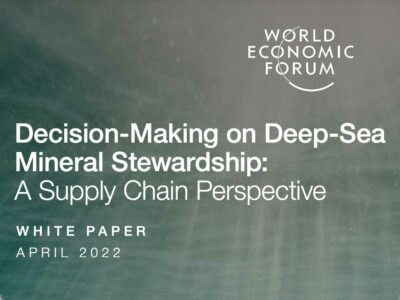
More knowledge, stronger stakeholder participation and greater consensus is needed for sound decision-making on deep-sea mineral stewardship, says new report
TDi Sustainability has authored a new World Economic Forum report which finds that decision-making on potential deep-sea mineral exploitation cannot yet serve the best interests of the planet and its people.
The report, Decision-Making on Deep-Sea Mineral Stewardship: A Supply Chain Perspective, identifies significant gaps in knowledge, stakeholder participation and consensus that impede sound decision-making on deep-sea mineral stewardship. It calls for decision-making systems to be strengthened, through the urgent closing of knowledge gaps on the potential impacts of deep-sea mineral exploitation, increased participation in decision-making from a wide range of stakeholders – including organizations in the metals and minerals supply chain – and consensus-building activities.
The report considers mineral stewardship broadly, asking how judicious decisions can be made on whether resources should be exploited, and if so, how. Deep-sea minerals have the potential to dramatically increase the availability of important metals, such as cobalt and nickel, the demand for which have been forecasted to raise. But mining would damage the seafloor ecology, potentially jeopardizing the broader ocean health and the people that depend upon it, leading to wider environmental and social effects.
Download the full report for free
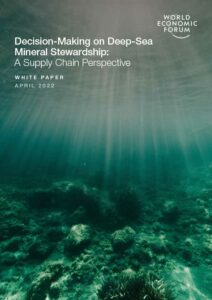
The report shines a light on critical gaps in knowledge, stakeholder participation and consensus. The closure of these gaps is urgent. Progress must be accelerated if current decision timeline is to be met. Several jurisdictions are currently developing exploitation regulations for deep-sea minerals, which could lead to commercial availability before the end of the decade. Without closing these gaps, decisions made on mineral stewardship may not be accepted by stakeholders.
“We face hard choices about the use of our planet’s resources. As we enter a new metals age, it is imperative that we consider all aspects of production in the round. Future mineral extraction will power our transition to a low-carbon economy and generate economic wealth. Yet it will also have negative impacts on people and ecosystems. This is true for all mineral sources, and deep-sea minerals are no exception. The best and least impactful choices for mineral supply must be made, but we can only deliberate on the choices if we are informed by sufficient science-based information, and listen to the perspectives of all stakeholders, including manufacturing companies that might one day be faced with the question of whether to use deep-sea minerals in their products,” said Assheton Carter, CEO of TDi Sustainability, a consulting firm specialized on responsible mineral sourcing that with the World Economic Forum produced this report.
The paper identified 18 gaps in current categories of knowledge for predicting the effects of deep-sea mineral exploitation. These gaps range in type from ocean science to economics, future technology developments and regulation. It was found that, due to these knowledge gaps, the potential effects that are currently least predictable are those that most directly affect people and planet. The potential spread pattern of ocean habitat-disturbing sediment plumes can be relatively well predicted, for example, but the effects on ecosystem and knock-on effects for communities whose livelihoods or values are tied to the sea are far less certain.
“There are many remaining gaps in scientific knowledge that must be addressed in order to make informed evidence-based decisions about managing and protecting deep sea ecosystems. As negotiations on international mining regulations continue to progress, there is an urgent need for more stakeholder engagement and more research on deep-sea mining,” said Dr. Douglas McCauley, Director of the Benioff Ocean Initiative and Member of Friends of Ocean Action.
The closure of the 18 knowledge gaps needs to be accelerated to facilitate judicious decision-making. Significant efforts are underway to build more knowledge in ocean science and seabed biology, but less attention is being paid to overall impacts of deep-sea mineral extraction on people and the global economy. In particular, little research is being undertaken to understand the potential impacts on metal supply and demand, and resultant market effects. Answers to the simple question “do we need to extract the minerals of the deep sea?” remain elusive. Without being able to answer this, even if knowledge gathering on the environmental impact and mitigation techniques have been accelerated, the question of whether those environmental costs can be justified for the overall good still cannot be easily addressed.
Participation in decision-making on deep-sea mineral exploitation is patchy and uneven too. The International Seabed Authority (ISA) is responsible for setting rules for deep-sea mineral exploitation beyond national jurisdiction, but many important stakeholder groups are under-represented in its processes. The report finds that 63% of official NGO Observers at ISA can be categorized as policy-focused and 34% can be categorized as conservation-focused. Stakeholder groups including communities with traditional, cultural or indigenous links to the sea, fishing communities, communities dependent on coastal tourism and communities affected by land-based mining could all be impacted by deep-sea mineral exploitation. Yet their direct representation in relevant decision-making at ISA is minimal. Representation from the global south is similarly low. Over 80% of NGO Observers at ISA are headquartered in OECD member countries. In national jurisdictions, the picture is more varied.
The paper’s authors uncovered deep consensus gaps between stakeholders. Regulators, deep-sea mineral contractors, manufacturers, metals exchanges, many civil society organizations and others agree that, if deep-sea mineral exploitation is to take place, it must be done responsibly. However, there is little consensus on what manner of exploitation, if any, could be considered responsible. Further knowledge-gathering on the potential effects of deep-sea mineral exploitation, and greater participation from stakeholders, could help to close this consensus gap.
“The closure of knowledge, participation and consensus gaps is urgent. Without doing so, it will be difficult for the decisions made on deep-sea mineral stewardship to be accepted by society, and in turn, the companies who are evaluating this issue through the responsible sourcing lens,” said Winnie Yeh, Lead, Responsible Sourcing, World Economic Forum. “All have a role to play, including the manufacturers and markets who source metals today. With their influence over their supply chains and a need to balance complex commercial, environmental and social considerations, these companies are uniquely placed to contribute to sound decision-making on mineral stewardship.”
The report calls for manufacturers and markets to play a role in line with the values of the burgeoning responsible sourcing movement. Manufacturers and markets should agree upon, and clearly articulate, the environmental, social and governance principles they expect for deep-sea mineral stewardship. By doing so now, they can take a stand for business responsibility that is without precedent in mineral sourcing: contributing to the pluralistic, evidence-based and critical decision-making needed to ensure that decisions taken serve the best interests of the planet and humankind.
In the face of unprecedented global challenges, including climate change, biodiversity loss, resource depletion, massive wealth disparities, and widespread poverty, the importance of sound mineral stewardship decisions cannot be overstated.
The key findings of the paper will be presented at a webinar on deep-sea mining hosted by the Cobalt Institute on 20 April, featuring Winnie Yeh, Responsible Sourcing Lead at the World Economic Forum. Registration is open now. In addition, the World Economic Forum’s Deep-Sea Minerals Dialogue will be hosting another webinar to present this white paper at the OECD’s 15th Forum on Responsible Mineral Supply Chains as a partner session on 5 May at 17:00 CET. Find out more here.
Media contact:
Victoria Veber, TDi Sustainability, on [email protected]
EDITORS’ NOTES:
Deep-sea minerals.
Deep-sea minerals occur on the seabed, at depths below 200 metres. They are present in the international seabed area, under the jurisdiction of the International Seabed Authority (ISA), and in several countries’ national jurisdictions.
Commercial extraction of deep-sea minerals has not yet begun, but relevant technologies have already been trialled, and several jurisdictions including ISA are developing exploitation regulations. A forecasted surge in demand for the types of minerals that lie on the seabed has strengthened the business case for their extraction.
Many of the environmental effects of deep-sea mineral exploitation will be unlike those on land. Deep-sea operations will not have tailings like conventional mining, for example, but they will create “plumes” of displaced sediment that can spread beyond the area in which operations take place.
Deposits of deep-sea minerals can be broken down into three categories: cobalt-rich crusts, seabed massive sulphides and polymetallic nodules:
Cobalt-rich crusts: Cobalt-rich crusts can form as a thin surface layer of up to 25cm on the tops and sides of undersea mountains known as seamounts. Extraction would entail grinding from the underlying rock using undersea machinery.
Seabed massive sulphides: Sulphide deposits occur when water rich in dissolved metals is ejected from below the seabed through hydrothermal vents. Over time, metal-containing solids can build up in beds tens of metres thick. Extraction of minerals from these deposits would involve cutting them from the seabed and creating a slurry of broken material to be pumped to the surface.
Polymetallic nodules: Polymetallic nodules (approximately the size of a potato) can be found on the seabed in some areas of the deep ocean. They form gradually over millions of years. Extraction entails pumping the nodules, which are unattached to the seabed, into a ship above without crushing.
The World Economic Forum Deep-Sea Minerals Dialogue
The report is published as part of the Deep-Sea Minerals Dialogue (DSM Dialogue) of the World Economic Forum. The DSM Dialogue creates an opportunity for businesses active in the downstream minerals value chain to learn about and discuss the implications of the potential emergence of minerals supplied from the deep seabed. The DSM Dialogue is working to inform manufacturers and markets about this important topic through balanced discussion and by providing salient information on the impacts associated with deep-sea mineral extraction in an impartial manner. The Forum does not take a position on whether deep-sea mineral extraction should operate at a commercial scale, but rather seeks to ensure that this important question is asked and that downstream businesses are able to contribute to addressing this question, in line with their sustainability objectives and based on the best information available.
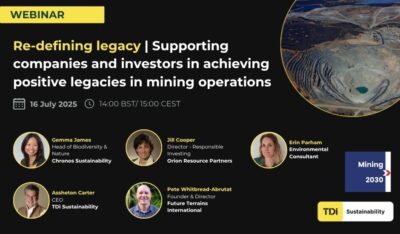 supply chain
supply chain
Re-defining legacy | Supporting companies and investors in achieving positive legacies in mining operations
3rd July 2025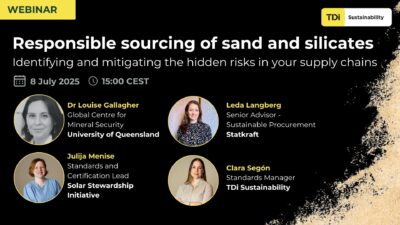 supply chain
supply chain
Responsible sourcing of sand and silicates | Identifying and mitigating the hidden risk in your supply chains
24th June 2025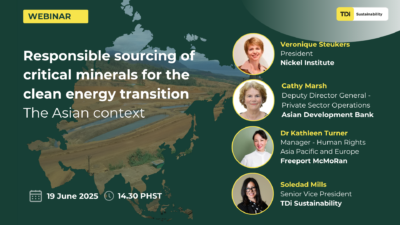 supply chain
supply chain
